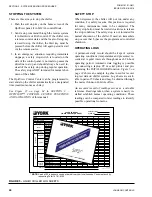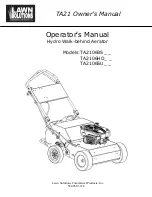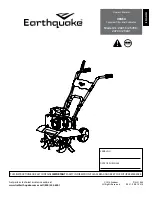
JOHNSON CONTROLS
17
SECTION 1 - SYSTEM FUNDAMENTALS
FORM 161.01-OM1
ISSUE DATE: 6/8/2018
1
WATER CIRCUITS
Flow Rate
For normal water chilling duty, the flow rates are per-
mitted at water velocity levels within the heat exchang-
er tubes between 0.91m/s and 3.66m/s (3.0 fps and
12.0 fps) for evaporators and 1.0m/s and 3.66m/s (3.3
fps and 12.0 fps) for condensers. Two pass units are
also limited to 134kPa (45ft H2O) water pressure drop.
The three pass limit is 201kPa (67.5ft H2O). Variable
flow in the condenser is not recommended, as it gen-
erally raises the energy consumption of the system
by keeping the condenser pressure high in the chiller.
Additionally, the rate of fouling in the condenser will
increase at lower water velocities associated with vari-
able flow, raising system maintenance costs. Cooling
towers typically have narrow ranges of operation with
respect to flow rates, and will be more effective with
full design flow.
Chillers can tolerate a 50% flow rate change in one
minute that is typically associated with the staging of
an additional chiller. A lower flow rate change is used
for better system stability and set point control. Proper
sequencing via the building automation system will
make this a very smooth transition.
Variable Primary Flow
Typically, the Variable Primary Flow (VPF) systems
are utilized in large chilled water plants, as VPF sys-
tems can offer lower installation and operating costs,
but require sophisticated control and flow monitor-
ing. YZ chillers operate successfully in VPF systems.
With a minimum allowable evaporator tube velocity of
0.5m/s (1.5 fps) for standard tubes at part load rating
conditions, YZ chillers accommodate the wide varia-
tion in flow required by many chilled water VPF ap-
plications.
Temperature Ranges
For normal water chilling duty, leaving chilled water
temperatures may range between 3.5°C (38°F) and
21.0°C (70°F), to obtain temperature deltas between
entering chilled water temperatures and leaving chilled
water temperatures of 1.7°C to 16.7°C (3°F to 30°F).
Water Quality
Water quality may affect the performance of any chill-
er through corrosion, deposition of heat-resistant scale,
sedimentation or organic growth. These will degrade
the chiller's performance and increase operating and
maintenance costs. The quality of the water supply for
the condenser and evaporator must be analyzed by a
water treatment specialist for practical and economical
liquid chiller applications. Typically, corrective water
treatment and periodic cleaning of tubes maintains a
chiller's performance. If water conditions exist which
cannot be corrected by proper water treatment, it may
be necessary to provide a larger allowance for fouling,
and/or to specify special materials of construction.
General Piping
All chilled water and condenser water piping is de-
signed, and should be installed in accordance with, ap-
proved piping practices.
• Chilled water pump and condenser water pumps
should be located to discharge through the chiller
to assure positive pressure and flow.
•
Piping should include offsets to provide flexibility
and be arranged to prevent drainage of water from
the evaporator and condenser when the pumps are
shut off.
• Piping should be adequately supported and braced
independently of the chiller to avoid strain on
chiller components.
• Hangers must allow for alignment of the pipe. Iso-
lators in piping and in the hangers are highly de-
sirable in achieving sound and vibration control.
• Piping should be arranged for ease of disassem-
bly at the unit for tube cleaning. All water piping
should be thoroughly cleaned of all dirt and debris
before final connections are made to the chiller.
Vents and Drain Valves
The following precautions may be taken to improve
chiller performance and maintenance.
• Evaporator and condenser waterboxes are
equipped with plugged vent and drain connec-
tions.
• If desired, vent and drain valves maybe installed
with or without piping to open drain.
• Pressure gauge equipped with stop-clocks and
stop-valves maybe installed in the intelts and out-
lets of the condenser and chilled water lines, both
places as close as possible to the chiller. An over-
hear monorail maybe used to facilitate servicing.
Содержание YZ MODEL A
Страница 10: ...JOHNSON CONTROLS 10 FORM 161 01 OM1 ISSUE DATE 6 8 2018 THIS PAGE INTENTIONALLY LEFT BLANK...
Страница 118: ...JOHNSON CONTROLS 118 FORM 161 01 OM1 ISSUE DATE 6 8 2018 SECTION 4 VSD OPERATION THIS PAGE INTENTIONALLY LEFT BLANK...
Страница 138: ...JOHNSON CONTROLS 138 FORM 161 01 OM1 ISSUE DATE 6 8 2018 SECTION 6 PRINTING THIS PAGE INTENTIONALLY LEFT BLANK...
Страница 142: ...JOHNSON CONTROLS 142 FORM 161 01 OM1 ISSUE DATE 6 8 2018 Appendix Material Safety Data Sheets...
Страница 143: ...JOHNSON CONTROLS 143 Appendix Material Safety Data Sheets FORM 161 01 OM1 ISSUE DATE 6 8 2018...
Страница 144: ...JOHNSON CONTROLS 144 FORM 161 01 OM1 ISSUE DATE 6 8 2018 Appendix Material Safety Data Sheets...
Страница 145: ...JOHNSON CONTROLS 145 Appendix Material Safety Data Sheets FORM 161 01 OM1 ISSUE DATE 6 8 2018...
Страница 146: ...JOHNSON CONTROLS 146 FORM 161 01 OM1 ISSUE DATE 6 8 2018 Appendix Material Safety Data Sheets...
Страница 147: ...JOHNSON CONTROLS 147 Appendix Material Safety Data Sheets FORM 161 01 OM1 ISSUE DATE 6 8 2018...
Страница 148: ...JOHNSON CONTROLS 148 FORM 161 01 OM1 ISSUE DATE 6 8 2018 Appendix Material Safety Data Sheets...
Страница 149: ...JOHNSON CONTROLS 149 Appendix Material Safety Data Sheets FORM 161 01 OM1 ISSUE DATE 6 8 2018...
Страница 150: ...JOHNSON CONTROLS 150 FORM 161 01 OM1 ISSUE DATE 6 8 2018 Appendix Material Safety Data Sheets...
Страница 151: ...JOHNSON CONTROLS 151 Appendix Material Safety Data Sheets FORM 161 01 OM1 ISSUE DATE 6 8 2018...
Страница 152: ...JOHNSON CONTROLS 152 FORM 161 01 OM1 ISSUE DATE 6 8 2018 Appendix Material Safety Data Sheets...
Страница 153: ...JOHNSON CONTROLS 153 Appendix Material Safety Data Sheets FORM 161 01 OM1 ISSUE DATE 6 8 2018...
Страница 154: ...JOHNSON CONTROLS 154 FORM 161 01 OM1 ISSUE DATE 6 8 2018 Appendix Material Safety Data Sheets...
















































